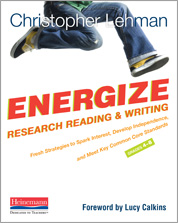Toward Authentic MS Research
Energize Research Reading and Writing: Fresh Strategies that Spark Interest, Develop Independence, and Meet Key Common Core Standards, Grades 4-8
By Christopher Lehman
(Heinemann, 2012 – Learn more)
Christopher Lehman’s book on teaching research-related reading and writing skills champions the idea that students should do more authentic research in the middle grades. It comes not a moment too soon. Deep into the age of information, research has become a vital part of adult life, and the forms it can take are growing fast.

Well-organized and helpful
Each chapter focuses on a different piece of the research process, from identifying topics and evaluating resources to note taking, writing with voice, and citing sources. Lehman consistently provides helpful and mostly fresh methods for supporting kids to do interesting research, with more independence than we usually see.
The highlights for me:
• Lessons that facilitate students designing and selecting their own formats for note taking, depending on their topic, focus and the source.
• Lessons that teach students to revise their notes along the way.
• Lessons that teach students to determine the best structure for their research-based writing — getting away from the classic research report summary or the 5-paragraph essay.
Each section of the book makes explicit connection to the teaching of Common Core standards, and each lesson is broken out into differentiated objectives. Lehman describes what different levels of students will get out of each activity, and how content area teachers can make use of the lesson. For teachers who are required to explicitly state these types of objectives to supervisors on daily lesson plans, this will be clarifying and timesaving.
The book is well organized throughout; it’s easy to look for and find something you need in the moment, without perusing the whole book, which teachers will appreciate.
Two concerns about style
Though I am inspired by the ideas in this book (at both macro and micro levels), it will not be my new best friend when it comes to teaching research. When I say “best friend,” I’m talking about the kind of book you pore over and return to all the time and hesitate to lend to anyone, lest they disappear with it.
There are two reasons for this, both having to do with style.
1. The actual lessons Lehman shares rely heavily on one instructional strategy: teacher modeling, with a lot of teacher talk.
Lehman scripts out what he says to students for teachers to read, but he doesn’t include much dialogue or response from students. For example, after lengthy teacher talk ( p. 73), Lehman writes, “Sam (student) then did just that, and the transformation was remarkable,” and moves on.
As a teacher with a constructivist orientation, this falls short for me. I cringe at the idea of students getting in the habit of copying the teacher’s thinking. I try to lead my students to discover concepts for themselves by designing classroom experiences and then discussing and reflecting on them. I’ll need to use my own imagination to create truly “energizing” experiences for my students around the objectives Lehman sets. I’m always up for that challenge, but it’s a limitation of the book as a comprehensive tool for me.
2. The style of the writing is also a bit flat. I have a hard time picturing the classrooms he teaches in and supports.
I’d like to have more detailed examples and stories of both successes and failures Lehman has encountered, to get a sense of the overall development, style and impact of this work in classrooms with real students. In many ways, my criticisms of Lehman’s teaching strategies with students and his presentation of his methods to teachers who read this book are similar. I’d like to have seen students and teachers more involved in the problem solving that Lehman had to do to develop these methods.
Telling stories about failures and successes along the road to improving practice is a powerful way to really illuminate the teacher thinking behind an approach. (Kylene Beers, Bill Ferriter and Donalyn Miller are great at this, for example.) Instead, Lehman spends too much time telling us what he does, and then telling us what we should do.
As a teacher-writer, I can relate to how tricky it is to find the right voice for a “how-to,” and I’ll certainly get some use out of Energize Research Reading and Writing. But, helpful though the book is, I can’t quite develop a teacher-to-teacher relationship with Lehman through his writing, which is what the best books about teaching practice achieve.
Ariel Sacks is an eighth grade English teacher and grade team leader at a middle school in Brooklyn, NY. A member of the Teacher Leaders Network, she writes the blog, On the Shoulders of Giants, and is writing a book on teaching Whole Novels, to be published in 2013 by Jossey Bass.





































2 Responses
[…] A book championing the idea that middle grades students should do more authentic research comes not a moment too soon, says ELA teacher Ariel Sacks. […]
[…] A book championing the idea that middle grades students should do more authentic research comes not a moment too soon, says ELA teacher Ariel Sacks. […]